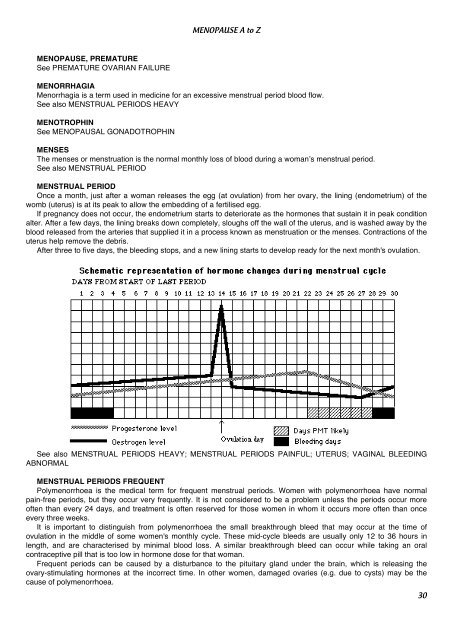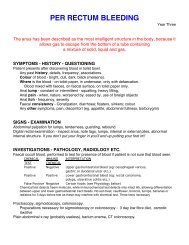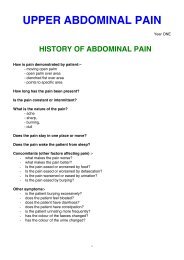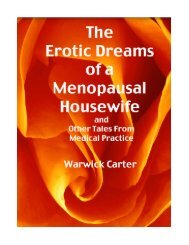Menopause A to Z.pdf - Medwords.com.au
Menopause A to Z.pdf - Medwords.com.au
Menopause A to Z.pdf - Medwords.com.au
You also want an ePaper? Increase the reach of your titles
YUMPU automatically turns print PDFs into web optimized ePapers that Google loves.
MENOPAUSE A <strong>to</strong> Z<br />
MENOPAUSE, PREMATURE<br />
See PREMATURE OVARIAN FAILURE<br />
MENORRHAGIA<br />
Menorrhagia is a term used in medicine for an excessive menstrual period blood flow.<br />
See also MENSTRUAL PERIODS HEAVY<br />
MENOTROPHIN<br />
See MENOPAUSAL GONADOTROPHIN<br />
MENSES<br />
The menses or menstruation is the normal monthly loss of blood during a woman’s menstrual period.<br />
See also MENSTRUAL PERIOD<br />
MENSTRUAL PERIOD<br />
Once a month, just after a woman releases the egg (at ovulation) from her ovary, the lining (endometrium) of the<br />
womb (uterus) is at its peak <strong>to</strong> allow the embedding of a fertilised egg.<br />
If pregnancy does not occur, the endometrium starts <strong>to</strong> deteriorate as the hormones that sustain it in peak condition<br />
alter. After a few days, the lining breaks down <strong>com</strong>pletely, sloughs off the wall of the uterus, and is washed away by the<br />
blood released from the arteries that supplied it in a process known as menstruation or the menses. Contractions of the<br />
uterus help remove the debris.<br />
After three <strong>to</strong> five days, the bleeding s<strong>to</strong>ps, and a new lining starts <strong>to</strong> develop ready for the next month's ovulation.<br />
See also MENSTRUAL PERIODS HEAVY; MENSTRUAL PERIODS PAINFUL; UTERUS; VAGINAL BLEEDING<br />
ABNORMAL<br />
MENSTRUAL PERIODS FREQUENT<br />
Polymenorrhoea is the medical term for frequent menstrual periods. Women with polymenorrhoea have normal<br />
pain-free periods, but they occur very frequently. It is not considered <strong>to</strong> be a problem unless the periods occur more<br />
often than every 24 days, and treatment is often reserved for those women in whom it occurs more often than once<br />
every three weeks.<br />
It is important <strong>to</strong> distinguish from polymenorrhoea the small breakthrough bleed that may occur at the time of<br />
ovulation in the middle of some women's monthly cycle. These mid-cycle bleeds are usually only 12 <strong>to</strong> 36 hours in<br />
length, and are characterised by minimal blood loss. A similar breakthrough bleed can occur while taking an oral<br />
contraceptive pill that is <strong>to</strong>o low in hormone dose for that woman.<br />
Frequent periods can be c<strong>au</strong>sed by a disturbance <strong>to</strong> the pituitary gland under the brain, which is releasing the<br />
ovary-stimulating hormones at the incorrect time. In other women, damaged ovaries (e.g. due <strong>to</strong> cysts) may be the<br />
c<strong>au</strong>se of polymenorrhoea.<br />
30









